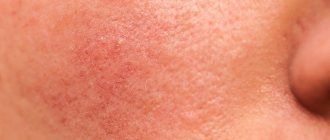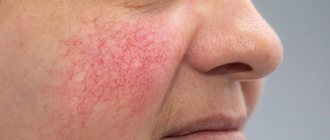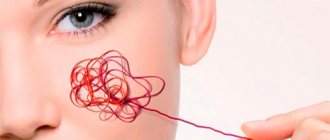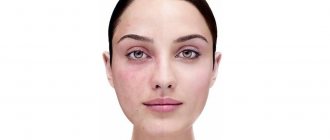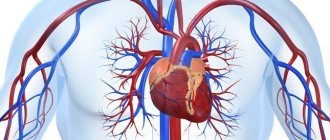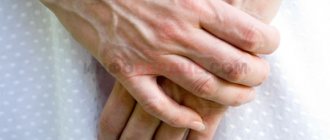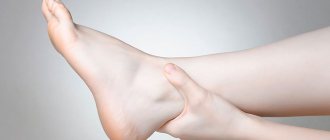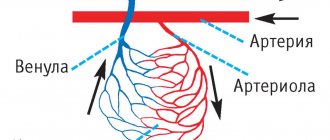Couperosis is a fairly common phenomenon among the population, especially the female part. Constant redness of the skin, spider veins or spider veins - at first glance, a common cosmetic problem that you want to eliminate and forget. However, everything is not as simple as it seems.
At risk are people with sensitive skin and those whose parents or other close relatives have experienced rosacea, since this disease can be inherited.
In addition to genetic predisposition, very often rosacea can be one of the symptoms of diseases of the internal organs, in which damage to the vascular wall occurs. Because of this, it is very important not only to eliminate the manifestation, but to identify the cause of the appearance of this pathology on the skin. The most problematic area is the face. Most often, capillary stars are located in the cheeks, chin and along the wings of the nose.
How does rosacea appear?
Due to various factors (genetic predisposition, poor lifestyle, the presence of a chronic disease), damage to the walls of blood vessels occurs, disruption of their elasticity, which leads to their ruptures and compensatory growth of the pathological vascular network. As a result, blood from the arterioles, bypassing the capillaries, enters the venules through shunts. Such vessels do not perform their trophic function properly: the delivery of oxygen and nutrients to the skin is disrupted. From this we draw the first conclusion why rosacea is so dangerous for us. Many stagnant vessels lead to disruption of skin metabolism and respiration, dryness, decreased immunity, and therefore to premature aging of the skin.
Medical contraindications
Although laser systems are considered one of the most effective options for solving the problem of eliminating rosacea, it is not suitable for everyone. If during the preliminary preparation phase the victim was diagnosed with specific chronic diseases, then you will have to look for an alternative way. We are talking not only about the fragility of blood vessels, but also about abnormalities of connective tissues.
Inflammatory diseases and accompanying processes of any location and origin are of particular danger. These can be both acute infectious lesions and dermatological diseases with a focus in any part of the body. Until the patient cures the main ailments, he will not be allowed to use laser help.
Pregnancy and the lactation period are added to the relative prohibitions. Here you just have to wait for more favorable circumstances. But oncological neoplasms of a benign or malignant type are more serious contraindications, since they require long-term therapy.
It will be impossible to carry out the plan correctly if a person at least two weeks before the appointment exposed his own skin to chemical or thermal active effects. We are talking about peeling, tanning or visiting a solarium.
Best materials of the month
- Coronaviruses: SARS-CoV-2 (COVID-19)
- Antibiotics for the prevention and treatment of COVID-19: how effective are they?
- The most common "office" diseases
- Does vodka kill coronavirus?
- How to stay alive on our roads?
Care will have to be taken to exclude from therapy medications that increase sensitivity to light. But before removing them from your treatment regimen, you should first consult with the doctor who prescribed them. It is likely that it will be more effective to wait until the end of the main course of treatment and then go to an aesthetic medicine center.
What causes rosacea on the face?
Modifiable risk factors for the progression of rosacea are:
- excessive sun exposure,
- overheating (local steaming of the facial skin, frequent visits to baths/saunas),
- abuse of alcohol, coffee, chocolate, as well as very spicy and hot foods
- smoking,
- regular trauma to the skin, especially for so-called home care (for example, scrubbing, peeling)
- incorrect selection of cosmetic procedures (deep peelings, warming solutions, hardware massages).
- pregnancy and childbirth
- lifting weights
Of course, it is extremely difficult to give up habits acquired over the years. You can start with a slight reduction in the presence of these risk factors, and already noticeably improve the quality of your skin. And in the future, completely abandon the harmful effects. It is important to understand that the sooner we eliminate the cause, the faster the skin will delight us with its healthy state.
In addition to predisposition and exposure to risk factors, rosacea can be caused by serious diseases of internal organs and serve as an important diagnostic symptom.
Cuperosis as a manifestation of diseases of internal organs.
The most common diseases that cause damage to the vascular wall:
- arterial hypertension, acute crisis or chronic malignant course, when systolic blood pressure is above 160 mmHg and cannot be corrected.
- diabetes mellitus, in which the level of glycated hemoglobin in the blood increases, which leads to disruption of oxygen metabolism in the vascular wall and causes tissue hypoxia. Subsequently, microangiopathy develops, leading to trophic disorders.
- vascular symptoms can be a warning sign indicating the presence of liver disease, an inflammatory process of an infectious or viral nature.
- autoimmune diseases, such as systemic lupus erythematosus and scleroderma, are also manifested by damage to the capillary network, which can serve as an early diagnostic symptom.
- hormonal disorders of various origins, ranging from dysfunction of sex hormones to disorders caused by brain tumors.
#4 stages of the disease and symptoms
Like any other disease, rosacea on the nose develops gradually and each stage is characterized by certain symptoms:
- At the first stage, dry skin with an increased level of sensitivity is noted. During washing, an unpleasant burning sensation may occur. Outwardly, no special changes are observed, the nose becomes a little redder, as if it had been rubbed during a long runny nose.
- In the second stage , redness spreads from the nostrils to the back of the nose, and vascular patterns begin to appear.
- The third stage is marked by a more obvious vascular network, and ulcers and pimples appear on the nose. Immediate treatment is required.
- At the last stage of the disease, the skin of the nose becomes much rougher and thicker, and bumps appear on the nose.
However, redness on the nose does not always indicate capillary disease. Damage to the subcutaneous vessels can cause severe frosts, a long runny nose or nasal injuries.
The difference between rosacea and temporary changes is simple - rosacea does not disappear after some time.
How to treat rosacea on the face?
There are several ways to treat rosacea and they all boil down to destroying and removing damaged capillaries.
Possible treatments:
- laser removal of blood vessels
- phototherapy
- electrocoagulation
- sclerotherapy
During sclerotherapy, a special drug is injected into the dilated vessels - a sclerosant, which blocks the capillaries, and over time they disappear without a trace. However, in the case of small vessels, this method does not work, therefore, it is mainly used to treat spider veins on the legs.
Electrocoagulation consists of introducing a subtle game into damaged capillaries, through which an electric discharge is released, destroying the vessel. The procedure is very long-term, moreover, it is painful and traumatic, as it is accompanied by a high risk of the formation of small scars. Therefore, today it is practically not used.
Recommendations
Are you prone to rosacea or suffer from its manifestations? Then take a few recommendations into account:
- use only special products for sensitive skin and drugs with anti-rosacea effect;
- moisturize your skin regularly;
- wash only with cool or warm water, hot and cold will cause a relapse;
- do not overheat or freeze;
- take vitamin and mineral complexes;
- strengthen capillaries with a contrast shower and facial exercises;
- Eat a diet rich in vitamin C.
Treatment of rosacea on the face with laser and phototherapy.
The most modern and safe way to remove blood vessels on the face is laser treatment. With laser coagulation, the walls of the vessel “glue” together, which leads to its instant disappearance. With larger vessels filled with blood, when exposed to a laser, its color darkens due to the oxidation of hemoglobin. The vessel becomes dark purple and disappears after a few days due to its destruction by immunocompetent cells. The treated area of skin turns red and swells slightly during the procedure; this reaction may last for several days.
It is recommended to perform such a procedure only in medical clinics with a medical license. This method is safe and most effective, in comparison with the previous ones, after it there are no scars or pigmentation left on the skin.
In Medical-Aesthetic, a neodymium laser HarmonyXL (Israel) with a wavelength of 1064 nm is used to remove spider veins on the face.
The ideal treatment for rosacea is a combination of laser treatment and AFT therapy or phototherapy. With the help of a laser, it is possible to get rid of dilated blood vessels that are visible to the eye, while AFT and phototherapy can remove general redness that occurs due to the expansion of many tiny capillaries. Thus, these two methods do not replace each other, but are selected depending on the caliber of dilated vessels and are an excellent combined treatment.
The newest method of treating rosacea is AFT therapy, which is an improved version of phototherapy, which allows you to halve the number of procedures and make them much more pleasant in terms of tolerability. More details about the relevant technology can be found in the corresponding section.
You can only get rid of rosacea using hardware methods. It is impossible to cure rosacea with the help of creams, tablets and other medicinal or cosmetic products; you can only make its manifestations less noticeable.
It should be noted that there are procedures aimed at treating the effects of rosacea and preventing damage to the vascular wall. Among them are biorevitalization, mesotherapy with vascular-strengthening drugs, plasma therapy, placentotherapy and botulinum therapy. The selection of procedures is carried out depending on the skin type, the causes of rosacea and its severity.
In addition to cosmetic procedures, it is recommended to undergo an examination in order to exclude a more serious disease or identify pathologies of internal organs. Such an examination may include blood tests (for infections, hormones, general, biochemical and immunological tests), urine analysis, ultrasound examination of the abdominal organs (especially the kidneys, adrenal glands, pancreas, echocardiography of the heart) and blood vessels, as well as other studies depending on the diagnosed pathology.
Be attentive to yourself and your loved ones; timely consultation with a doctor provides great guarantees for a quick recovery.
Couperosis on the face: treatment with folk remedies at home.
The most proven and effective way to treat and prevent rosacea is cold tea lotions made from lightly brewed black tea. Just 15 minutes 2 times a day for a week will allow you to feel a noticeable effect. Do not use ice to wipe your face, as this can lead to hypothermia of the skin, vasospasm and compensatory dilation of neighboring capillaries, which will increase the manifestations of rosacea.
The herbal mask is made up of calendula, chamomile, horsetail, yarrow and horse chestnut flowers. Equal parts of each component are mixed with boiling water until a thick paste is formed and infused for ten minutes. Then the resulting slurry is cooled and applied to a gauze mask, which is placed on the face. After 15 minutes, the mask is washed off with a decoction of chamomile or yarrow.
This is just a small part of our secrets.
You can get more detailed advice from your cosmetologist. Dermatologist, cosmetologist: Lachinova Natalya Mikhailovna
Question answer
As soon as you notice signs of this pathology, reconsider your diet. Remove from the menu too spicy, fried foods, and dishes with high fat content. After this, do not hesitate to go to the doctor. In most cases, doctors prescribe moisturizers and creams that promote regeneration. At this stage, massage is useful, as it has a positive effect on blood circulation.
There is more than one remedy designed to treat the disease. But some have gained great popularity. This is Aaven Dirozeal. This name is given to a cream that eliminates redness and removes age spots. In addition, it is recommended to use Troxevasin. This remedy has a positive effect on blood vessels and capillaries. Another wonderful drug is Ascorutin. It contains important vitamins, rutin, and ascorbic acid. These substances make capillaries less brittle and restore them.
Yes, surgery is performed to correct this problem. The doctor removes the defect manually. This is a painful manipulation, after which you need to recover for a long time. They rarely resort to surgery, since it is generally not possible to eliminate all the affected vessels.

